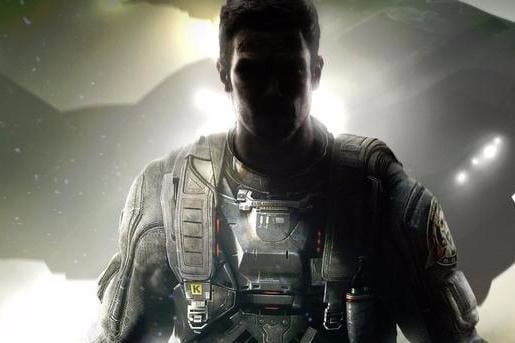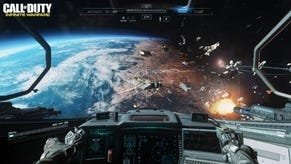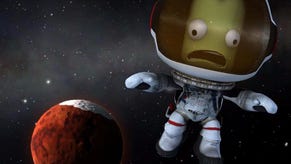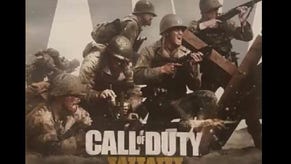Call of Duty: Infinite Warfare's campaign is slick, morbid and a bit dull
Infinity Ward delivers a story of heroic sacrifice that's in love with the dead.
Editor's note: Ahead of our full review next week after we've had time to get to grips with the game's online component, here are Edwin's impressions of the single-player campaign.
Among the first things you do in Call of Duty: Infinite Warfare is walk through a memorial, running your eyes over marble slabs engraved with the names of the fallen. As I later discovered, the soldiers so remembered are in fact Infinity Ward employees - senior animator Dustin Kimmich, character artist Sylvia Miller and art director Brian Horton among others. Playing footage of the scene back, I couldn't help but think of those "dearly departed" souls the artists had neglected to include. Studio co-founders Vince Zampella and Jason West, to name a couple off the top of my head. Steve Fukuda, lead designer of the very first Call of Duty back in 2003. Mohammad Alavi, the incorrigible dabbler behind the legendary "Crew Expendable" and "No Russian" missions.
If these former staffers are absent from the honour roll, following years of bitter litigation between Activision, West and Zampella over an exodus of staff to Respawn Entertainment, their legacy is indelible throughout the new game. It's there in the presence of a two-man sniper mission, cut from the same cloth as Alavi's "All Ghillied Up" - the backdrop may be an asteroid field rather than a radioactive wasteland, but every time your ally asks you to pick a target, it's as though you're back in Chernobyl with Captain MacMillan. It's there, too, in the revival of the UAV, Call of Duty's best-known and most effective killstreak - a reassuring sight alongside new (or at least, newly reimagined) toys like the richochet-friendly Claw energy rifle, the self-piloting R-C8 battle mech or the scuttling Seeker grenade. Above all, it's there in the game's unabashed love of interfacial technology and military procedure - a crackling cloud of HUD readouts, heatmaps and comms chatter, guiding you into and out of the folds of each level.
It may seem unfair to dredge up such precedents, rather than focusing on the accomplishments of those who still work at Infinity Ward, but it's hard not to when the game you're playing is so utterly obsessed with the fallen. Infinite Warfare isn't just a more conservative game than it's said to be, for all the Destiny-defying majesty of its planetary vistas and the wild abandon of its outer space dogfights. It's a story about the necessity of measuring up to those who have gone before, a story so congested by reverence for the immortal dead that it never manages to say anything else.
The first mission (a prologue set on Jupiter's icebound moon Europa aside) sets the tone unambiguously. It's essentially the attack on Pearl Harbour with a splash of Battlestar Galactica - the opening gambit of a studio that sees in science fiction a way of escaping the murky, undecided present and returning to the cosy era of the "just war", dressed up as a trip to the stars. The Earth's entire space navy is gathered in the sky over Geneva for a parade when this year's pantomime villains, the Settlement Defence Front, spring a devastating ambush, turning the city's automated railgun turrets against the fleet. In the process, you're introduced to a modest handful of mechanical innovations: frags that courteously highlight any enemies they don't kill outright, energy weapons that do extra damage to robots, and anti-gravity grenades that hoist opponents out of cover.
It's a nasty turn of events for Geneva's gentrified docklands, but a real career windfall for protagonist Nick Reyes, who is handed the keys to the cruiser Retribution after its captain sacrifices himself to chase off an SDF carrier. In addition to giving you free roam of the solar system - or at least, around 30 scenarios scattered across it, including nine optional missions tied to (largely inessential) character upgrades - your abrupt promotion sets the stage for another tale about shouldering the burdens of command, as Reyes comes to accept that sometimes soldiers must die for the sake of a mission. This is a moral Infinite Warfare hammers home relentlessly, at the expense of context or reflection. Practically every dialogue line that isn't a buddy-bonding quip or navy l33tspeak is about the desirability - indeed, the inevitability - of a selfless demise in battle, to the extent that the broader reasons for those sacrifices vanish out the airlock.
Call of Duty has never been known for dwelling on whys and wherefores, of course, but the Modern Warfare series at least offered glimpses of a credibly messy universe between firefights - a world of complications swamped but not erased by the needs of the moment. Think of your harrowing spell in the head of a deposed dictator during Modern Warfare's "The Coup", for example. Infinite Warfare is too mesmerised by the nobility of dying in action to bother with such insights, and one consequence is that its warring factions are hard to tell apart. "Care clouds judgement," intones Kit Harington's Admiral Socha, a nemesis who is little more than an expression of pinched resentment doling out watery fascist slogans in cutscenes. "Hesitation is a hole in the head," offers up Reyes in a later scene. Same sentiment, slightly more PR-friendly wording.
The story's morbid priorities are encapsulated, above all, by Ethan, a sentient robot who joins your ranks early on in the proceedings. The usual character arc for a synthetic lifeform like Ethan is to discover his inner humanity, Commander-Data-style, but here, Ethan is the ideal other characters must live up to - charismatic, devoted, efficient, fearless and selfless. He's the perfect soldier, and Infinite Warfare is fundamentally a story about perfecting soldiers, turning personalities into presentable killing machines. The script isn't without charm - the cast are quite a diverse and likeable bunch, with some zesty performances from Claudia Black and Jamie Gray Hyder - but at its core there is an air of dreadful, calculating coldness. Yes, casualties are to be expected in combat, but any work of military fiction that makes such a naked virtue of throwing your troops on the fire strikes me as little more than propaganda.
Whenever Infinite Warfare isn't preaching about Tough Decisions, it's revelling in the experience of being a starship captain. Conceived with the input of both NASA and the US Navy, the Retribution is a bustling yet tightly choreographed hub environment that makes Mass Effect's Normandy look positively antique.
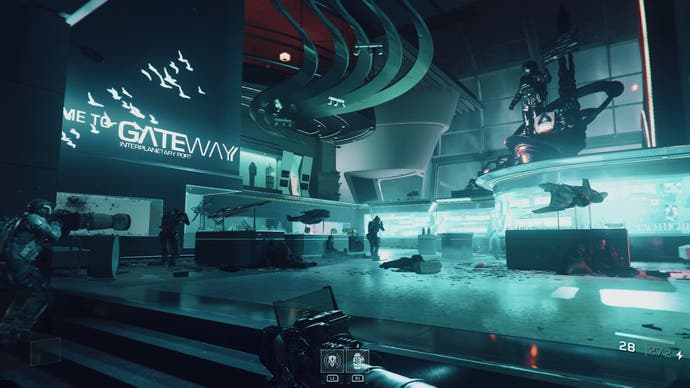
More than any structural McGuffin before it, the ship imposes a stateliness on the game's mission flow, an exactness of advance and retreat. Pick a mission at the map table, and you'll be catapulted to a different orbit in a brilliant riff on a submarine's diving protocols - crew members rattling orders into wired phones, FTL drives unfolding from the glacial ramparts of the flight deck. From there it's off to the armoury, where a laconic warrants officer prints out your weapons - you can go with recommended options or fashion your own, using rarer guns you've acquired in the field. Then you take the elevator to the hangar - an opportunity for a bit of restorative banter with your hard-headed subordinate Lieutenant Nora Salter - where a lady in giant headphones escorts you to your Jackal interceptor past flocks of cheerful engineers and lumbering R-C8s.
Most of the missions conclude with a space battle, so you'll generally have to land your Jackal, too - gliding through holographic hoops till a drone floats up from its niche on the runway to seize your craft by the nose. Cut to the hall outside the bridge, and you'll always pass an anonymous crew member who coughs up a bit of mission-specific praise, ticking the box labelled "reactive world" without bogging you down. Turn left and you'll find your back way to the bridge to continue the story. Turn right and you'll walk past a training booth (there is always a woman playing some kind of VR game - one can only hope it isn't Star Citizen) to the mess, where you can watch news broadcasts about your exploits while underlings whoop their appreciation. It's a well-greased narrative feedback loop that sells the illusion of an entire capital ship at your disposal, while never allowing you to lose yourself within it.
Am I giving too much attention to the intermissions? That's partly because the missions themselves are quite dull, however grand of premise or slickly paced. The majority trade heavily on ideas from previous games. There's one where you must escort a bipedal mech through a refinery, aiming its launchers at gaggles of petrified infantry with a wrist-mounted targeting screen. There's one where you have to chase somebody through a thicket of apartments and courtyards prowled by snipers, like Roach running down the arms dealer in Modern Warfare 2's Favela chapter.
The game's breathtaking interplanetary environments aren't just there for appearances - you can expect the odd 360 degree zero-G gunfight and a mission seemingly inspired by Danny Boyle's Sunshine, which unfolds on an asteroid that is blanketed every few seconds in solar fire. For the most part, though, you'll be fighting much as in Black Ops 3 - using the wall-run to get behind people, or the boost-jump to get away from them, whether the terrain be an ice cavern on Europa or the bleached and contorted surface of the Moon. The game's arsenal is the usual assortment of rifles, shotguns, SMGs and LMGs, most of them pleasantly exotic to the eye but the same old question of recoil, range, firing modes and projectile spread in practice.
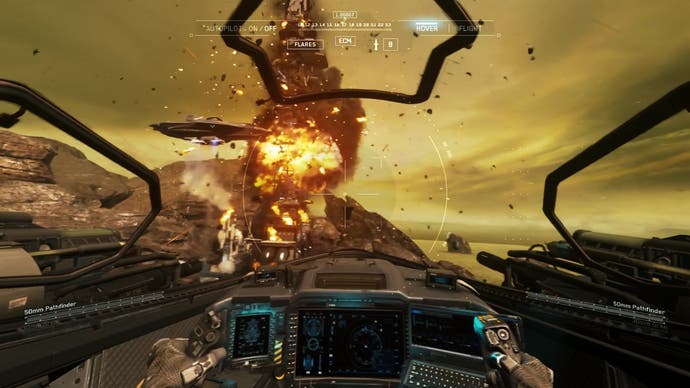
Ship-to-ship combat is a nice change of pace, at least, though not quite the shot in the arm the game needs. It sees you swatting fighters with missiles and auto cannons, then switching to a slow-firing siege gun to knock the turrets off a carrier or two - a mix that will strike any halfway-seasoned X-Wing pilot as desperately rote, but executed with plenty of dazzle. The simulation is skin-deep - high-velocity asteroid collisions are a nuisance rather than lethal, and you're armed with an inexhaustible supply of defensive flares - but the main drawback of this side of the game is simply the number of missions devoted to it. By the fifth time you corner a rival ace against the belly of the cruiser it's protecting, you'll have seen everything space combat has to offer.
Given how much stress Call of Duty: Infinite Warfare's script lays on the idea of sacrifice, it's deflating, though hardly out of character for this series, that the campaign is so risk-averse. Few first-person shooter single player components are as sinuously and precisely constructed, and even given the current embarrassment of sci-fi simulations, the game's locales are a sight for sore eyes. But few Call of Duty games are so tentative, once you look past the smoothly articulating machinery of their hub and narrative structures, and then there's that queasy fixation with dying for the cause. Perhaps the multiplayer will save it, but so far this year's Call of Duty feels a little dead inside.
